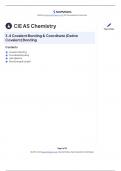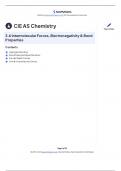Haydenash
On this page, you find all documents, package deals, and flashcards offered by seller haydenash.
- 18
- 0
- 2
Community
- Followers
- Following
20 items

Metallic Bonding
Metallic bonding involves metal atoms arranged in tightly packed lattice structures, where the outer shell electrons are free to move. These free-moving electrons, known as delocalised electrons, are not bound to any specific atom, allowing them to create a “sea” of electrons around positively charged metal ions. This movement of electrons contributes to the stability of the lattice as the positive charges repel each other, maintaining the structure. The strong forces between the positive me...
- Package deal
- Summary
- • 3 pages •
Metallic bonding involves metal atoms arranged in tightly packed lattice structures, where the outer shell electrons are free to move. These free-moving electrons, known as delocalised electrons, are not bound to any specific atom, allowing them to create a “sea” of electrons around positively charged metal ions. This movement of electrons contributes to the stability of the lattice as the positive charges repel each other, maintaining the structure. The strong forces between the positive me...

Covalent Bonding & Coordinate (Dative Covalent) Bonding
The content discusses covalent bonding, including the definitions and types of covalent bonds, such as single, double, and triple bonds. It explains how covalent bonds form through the sharing of electrons between nonmetals, creating stable electron configurations similar to noble gases. Various examples illustrate these concepts, including hydrogen, chlorine, ammonia, and methane. The document also covers coordinate bonding, where an electron-deficient atom forms a bond by receiving a lone pair...
- Package deal
- Summary
- • 22 pages •
The content discusses covalent bonding, including the definitions and types of covalent bonds, such as single, double, and triple bonds. It explains how covalent bonds form through the sharing of electrons between nonmetals, creating stable electron configurations similar to noble gases. Various examples illustrate these concepts, including hydrogen, chlorine, ammonia, and methane. The document also covers coordinate bonding, where an electron-deficient atom forms a bond by receiving a lone pair...

Shapes of Molecules
The content discusses the shapes of molecules based on the Valence Shell Electron Pair Repulsion (VSEPR) theory. According to VSEPR, electron pairs repel each other, leading to specific molecular shapes that minimize these repulsive forces. The theory emphasizes that different types of electron pairs (bonding and lone pairs) have varying repulsion strengths, influencing the overall shape of the molecule. Key points include the dominance of lone pairs in repulsion, the identification of shapes an...
- Package deal
- Summary
- • 9 pages •
The content discusses the shapes of molecules based on the Valence Shell Electron Pair Repulsion (VSEPR) theory. According to VSEPR, electron pairs repel each other, leading to specific molecular shapes that minimize these repulsive forces. The theory emphasizes that different types of electron pairs (bonding and lone pairs) have varying repulsion strengths, influencing the overall shape of the molecule. Key points include the dominance of lone pairs in repulsion, the identification of shapes an...

Intermolecular Forces, Electronegativity & Bond Properties
The text discusses intermolecular forces, particularly focusing on hydrogen bonding, bond polarity, and Van der Waals’ forces within the context of CIE AS Chemistry. It explains hydrogen bonding as the strongest form of intermolecular bonding, requiring a highly electronegative atom like oxygen or nitrogen and an -OH or -NH group. The text highlights how hydrogen bonding contributes to the unique properties of water, including high melting and boiling points, high surface tension, and anomalou...
- Package deal
- Summary
- • 22 pages •
The text discusses intermolecular forces, particularly focusing on hydrogen bonding, bond polarity, and Van der Waals’ forces within the context of CIE AS Chemistry. It explains hydrogen bonding as the strongest form of intermolecular bonding, requiring a highly electronegative atom like oxygen or nitrogen and an -OH or -NH group. The text highlights how hydrogen bonding contributes to the unique properties of water, including high melting and boiling points, high surface tension, and anomalou...

Dot-&-Cross (Lewis Dot Structure) Diagrams
The file discusses dot-and-cross diagrams, specifically focusing on how atoms follow the expanded octet rule and the incomplete octet rule in covalent compounds. It also touches on the concept of ionic compounds and how atoms transfer their outer/valence electrons. The diagrams illustrate how atoms achieve noble gas configuration through sharing or transferring outer valence electrons.
- Package deal
- Summary
- • 12 pages •
The file discusses dot-and-cross diagrams, specifically focusing on how atoms follow the expanded octet rule and the incomplete octet rule in covalent compounds. It also touches on the concept of ionic compounds and how atoms transfer their outer/valence electrons. The diagrams illustrate how atoms achieve noble gas configuration through sharing or transferring outer valence electrons.

The Gaseous State: Ideal & Real Gases & pV = nRT
The file discusses the relationship between the volume, temperature, and pressure of a gas. It explains how changes in volume and temperature affect the collision frequency of gas particles with the container wall, and how these changes influence the pressure of the gas. Additionally, it highlights the direct and inverse proportional relationships between volume and pressure, as well as temperature and pressure, and mentions that a graph of gas temperature plotted against pressure results in a s...
- Summary
- • 9 pages •
The file discusses the relationship between the volume, temperature, and pressure of a gas. It explains how changes in volume and temperature affect the collision frequency of gas particles with the container wall, and how these changes influence the pressure of the gas. Additionally, it highlights the direct and inverse proportional relationships between volume and pressure, as well as temperature and pressure, and mentions that a graph of gas temperature plotted against pressure results in a s...

Bonding and Structure
The file discusses different types of chemical bonding and lattice structures, including covalent bonding with simple and giant covalent lattice structures, as well as metallic lattices. It explains the characteristics and properties of compounds with these structures, such as their melting and boiling points, solubility in water, ability to conduct electricity, and the energy required to break their lattices. Additionally, it highlights specific examples of compounds and their behavior based on...
- Summary
- • 10 pages •
The file discusses different types of chemical bonding and lattice structures, including covalent bonding with simple and giant covalent lattice structures, as well as metallic lattices. It explains the characteristics and properties of compounds with these structures, such as their melting and boiling points, solubility in water, ability to conduct electricity, and the energy required to break their lattices. Additionally, it highlights specific examples of compounds and their behavior based on...

Enthalpy Change, ΔH
The PDF provides an in-depth explanation of enthalpy change (ΔH), focusing on how energy changes during chemical reactions. It differentiates between exothermic (energy-releasing) and endothermic (energy-absorbing) reactions, with diagrams illustrating the energy pathways. Key concepts like standard enthalpy changes and reaction pathway diagrams are discussed. It also explains how bond energies affect reactions, with detailed examples showing how to calculate enthalpy changes using bond energie...
- Summary
- • 20 pages •
The PDF provides an in-depth explanation of enthalpy change (ΔH), focusing on how energy changes during chemical reactions. It differentiates between exothermic (energy-releasing) and endothermic (energy-absorbing) reactions, with diagrams illustrating the energy pathways. Key concepts like standard enthalpy changes and reaction pathway diagrams are discussed. It also explains how bond energies affect reactions, with detailed examples showing how to calculate enthalpy changes using bond energie...

Hess's Law
The PDF explains Hess's Law, which states that the total enthalpy change of a chemical reaction is independent of the reaction pathway as long as the initial and final conditions are the same. It introduces Hess cycles, illustrating how to use them to calculate enthalpy changes that cannot be determined experimentally. The document includes worked examples, such as calculating enthalpy changes and bond energies using energy cycles, providing step-by-step guides for solving these problems. It ...
- Summary
- • 9 pages •
The PDF explains Hess's Law, which states that the total enthalpy change of a chemical reaction is independent of the reaction pathway as long as the initial and final conditions are the same. It introduces Hess cycles, illustrating how to use them to calculate enthalpy changes that cannot be determined experimentally. The document includes worked examples, such as calculating enthalpy changes and bond energies using energy cycles, providing step-by-step guides for solving these problems. It ...

REDOX Reactions
The PDF provides a detailed overview of redox processes, focusing on electron transfer and changes in oxidation number. It explains the concept of oxidation states, outlines the rules for determining oxidation numbers, and demonstrates how to balance redox reactions. The document covers the identification of oxidizing and reducing agents, as well as the significance of these agents in chemical reactions. Additionally, it introduces key redox-related concepts like oxidation, reduction, and dispro...
- Summary
- • 15 pages •
The PDF provides a detailed overview of redox processes, focusing on electron transfer and changes in oxidation number. It explains the concept of oxidation states, outlines the rules for determining oxidation numbers, and demonstrates how to balance redox reactions. The document covers the identification of oxidizing and reducing agents, as well as the significance of these agents in chemical reactions. Additionally, it introduces key redox-related concepts like oxidation, reduction, and dispro...
